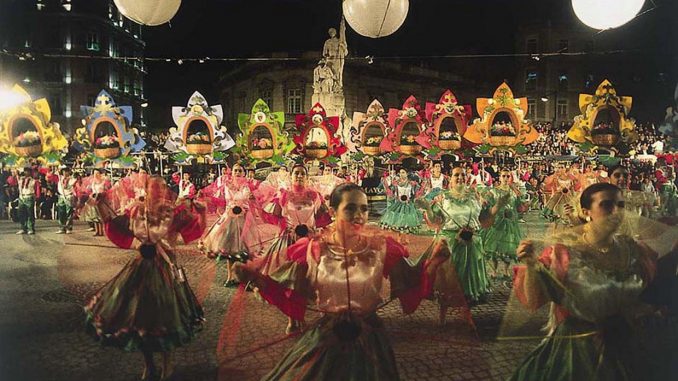
Two Lisbons live together in the same place, and represent two different urban imaginaries – argues our friend Dani Malet Calvo in his Thesis. On one side there is the project of the “modern” and enlighted Lisbon, the rational grid planified over the ruins of 1755 earthquake, linked to the figure of Marqués de Pombal. On the other, there is the “old” Lisbon, imagined in the narrow streets of the old neighbourhoods (bairros), whose urban forms are supposed to go along with some pre-modern traditions and styles of socialization. The ruling classes had been adversing this second Lisbon for centuries; but their need to integrate it in the hegemonic process of representations, gave birth to the annual ritual of the Marchas dos Santos populares, an “invention of tradition” inherited by Salazar’s dictatorship and celebrated on the eve of Saint Anthony’s day. “Through this ritual the municipal authorities legitimate their urban rule, feeding on the heritage value and the authenticity of the strong neighbourhood identities of the central area. This night is an effort to bring back to life an impossible memory, that of the organic unity lost in some faraway past, before the Marqués separated the city in two halves, before the ‘Pombaline Split’ (la Fisura Pombalina), when all Lisbon was bairrista” (from Manuel Delgado’s blog review). Dani studied the interactions and conflicts among the two Lisbons divided by the “split” of modern planification, throught the ethnography of a central space, Praça do Rossio. There he explored some distinctive forms of appropriation of the public space in the present, as those put in place by the lusoafricans in a corner of the plaza; he also studied new processes of commodification and thematization of the old bairros, where tourists and even Erasmus students play a key role.
- Dani MALET (2011), “A ver quem Passa. O Rossio: proceso social y dinámicas interactivas en una plaza del centro de Lisboa”. Doctoral Theses, UB.
- Dani MALET (2013), “Procesos de revalorización patrimonial en el barrio de Alfama: el papel de los estudiantes Erasmus en la tematización de la ciudad“, Etnográfica, Revista do Centro em Rede de Investigaçao em Antropologia, vol.17(1)
- Marluci MENENEZ (2011) “‘Todos’ na Mouraria? Diversidades, desigualdades e diferenças entre ôs que vem ver o bairro, nele vivem e nele querem viver”, XI Congreso Luso-Afro-Brasileiro de Ciencias Sociales, Salvador, august 2011. Menenez also wrote Mouraria, Retalhos de um Imaginário: significados urbanos de um bairro de Lisboa (2004), Oeiras Celta ed.
- A treasure in portuguese urban studies in the time of mass urbanization: “People aren’t things to be put in drawers”, Sociedade e Territorio, n.20 (1994) [PDF]
- Casa da Achada – Fundaçâo Mário Dionísio association [web], in Mouraria neighbourhood, heir of the historic association Abril em Maio (1994-2005) [info]
- Web of the Espacio Colectivo Autogestionado (ES.COL.A.) do Alto da Fontinha, in Porto, that during one year was a comunitary space [web]; and last but not least, Occupied Lisbon, a story of squatting in Lisbon in the last 20 years [web]